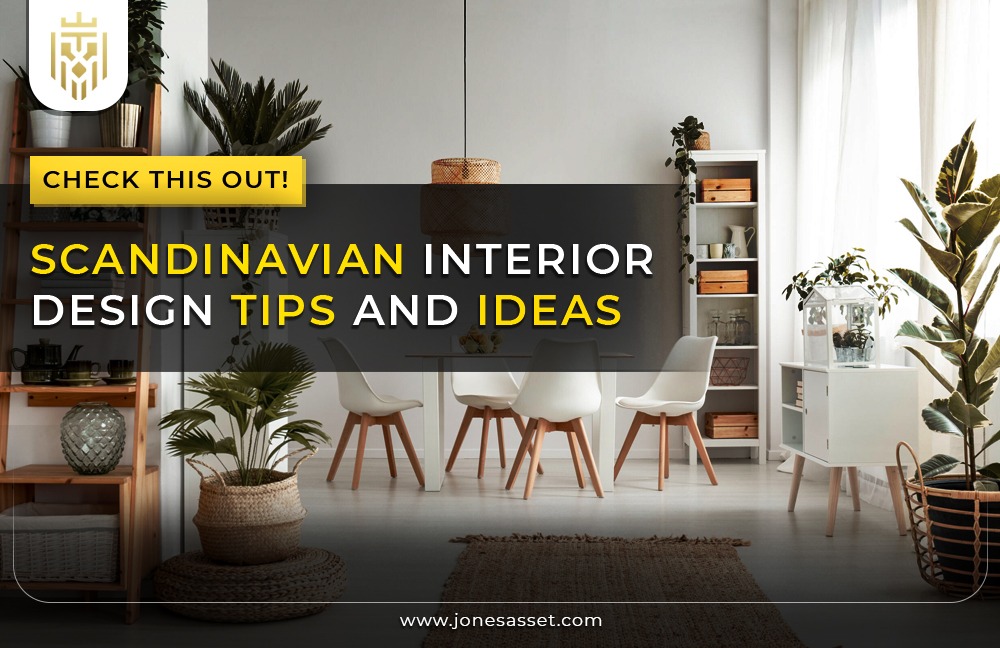What is a Scandinavian Interior Design:
Scandinavian interior design is a type of interior design that originated from the Nordic countries highlighting simplicity, functionality, and incorporating nature in everything. In design terms, it has simplicity in features, low contrast of colors, and variety in the detailing to make a warm ambiance. As for the interior design, natural light is an essential part of the concept, with minimum clutter in order to create a peaceful atmosphere for the individuals.
The term, “ hygge” literally, meaning “coziness” is a Danish and Norwegian term that is sometimes incorporated into the concept. This means that hygge denotes feelings of contentment or comfort which Scandinavian concepts try to tap into through the use of soft lighting, soft furnishings, and ambient settings that are not cluttered.
Elements of Scandinavian Interior Design:
Appreciate genuine and exquisite wood and leather, seemingly endless shades of grey and white with occasional bursts of pastels, minimalistic and practical furniture, and daylight. The textures prove very vital in consideration of textiles as they add warmth and comfort.
Textiles:
Textiles are an important feature of Scandinavian design and are crucial for creating warmth and layering. Some of the most common are the widely used materials such as wool, linen, and cotton. These textiles mainly feature subdued colors and relatively plain narrative images, possibly stripes or geometrical shapes. Toss pillows, rugs, and throws are placed stylishly to help add an element of warmth and comfort.
Glass:
In Scandinavian interior design, glass is incorporated to allow for the reception of more light and also to provide the ambiance of having no walls. Tall windows are a primary feature of many of the designs, which helps to provide plenty of natural lighting inside. Essential accessories made of glass, such as vases, table lamps, and partitions, do not overcrowd the space and do not divert attention from principal elements emphasizing the essentiality of the design.
Metal:
In Scandinavian design, the usefulness of metal is limited to the contrast and the infusion of a contemporary spirit. Plain metals are brass, copper, and steel which are normally seen in the lighting fixtures, hardware parts, and the legs of the furniture. These metals give the homes what could be described as a clean, shiny appearance that fits well with the wooden textures and the subdued colors frequently used in the style.
Plastic
The use of plastic is limited to a few items in Scandinavian design where it is applied in mostly placed use in well-designed items such as modern chairs or storage containers. Sustainability and quality remain the focus, and thus while there is use of plastics among the primary materials, it is mostly in the high quality and durable ones that integrate well with other natural materials as well as the general minimalist design concept of the space.
Ceramics:
In Scandinavian design, the use of ceramics means hand-crafted personal accessories are used. Objects, for example, vases, bowls, and mugs are represented with quite strict and laconic forms and are often solid-colored or painted in soft tones, or pastels. Symmetrical and asymmetrical balance is more considered here as well as the distinct focus on form and ornament; ceramics add warmth to the otherwise domestic environment and are also used for practical purposes within the apartment.
Light:
One of the key aspects of Scandinavian design is the use of natural light and the principles associated with the idea of bringing as much of it as possible into the designed interior. Lighting is also deliberately installed with simple elegance, including the use of ambient, task, and accent lights while other artificial lighting installations chosen are minimalist and fitted appropriately to achieve the warmth of the space.
Wood:
Treewood is one of the primary materials utilized in Scandi interior design and is even preferred for its organic and cozy appearance. Temporary woods such as pine, birch, Oak, and any other light-colored exotic woods are familiarly used in flooring, furniture, and decorative features. An example is the utilization of wood material in the interior design, which empowers the appearance of nature and lays emphasis on the utilization of wooden furniture in the improvement of the feel of the minimalist design.
Must-haves of a Scandinavian Decor:
Some essential prerequisites for creating the Scandinavian style include the use of natural materials in furniture, a minimum of furniture items, careful attention to lighting, and warm textiles. Other features also include low-key colors, only the necessary furniture and features, and some greenery placed around to enlighten the feeling of the natural environment.
Fluffy Textiles:
Among the mandatory elements of Scandi interior design, fluffy throws, cushions, and rugs are still high on the list. They create a visual interest, giving the physical interior something more than just a simple smooth, and plain surface. Wool, sheepskin, and fake fur are common fabrics associated with hygge as people prefer warm and cozy textiles.
Nature-Inspired:
Floral motifs are reported to be important in Scandinavian interior design, which is closely related to the region’s devotion to the natural world. These minimalistic accents concern the use of natural wood and stone, the presence of indoor flowers and other plants, as well as accessories with botanic ornaments. These elements add to the interior a note of calmness and, in combination with the freshness of the green color, become its distinguishing characteristic.
Bold Lighting Statements:
Illumination in Scandinavian decorating theme also encompasses design accent, which can be seen in the use of chandeliers above. Suspension lights, floor lamps, and sconces are some types of lamps that are associated with the generation of modern contemporary designs. They consist of materials such as brass or even copper and are mostly needed to offer sufficient lighting to a room as well as to offer a trendy design feature.
Minimalist Patterns:
It is common knowledge that the Scandinavian style is simple, the patterns are minimalist and this makes the overall style clean and not cluttered. Bland patterns consist of plain stripes, geometrical shapes, and tone-down flora patterns. These designs are generally applied to textiles, wallpapers, and other accessories and keep the decoration scheme interesting or ornate without being too busy or overbearing.
Natural Materials:
Natural elements are indispensable in the context of Stylistically, the maximalism of Scandinavia is based on sustainability and quality. Spruce, sycamore, maple, and cedar are some of the familiar types of light woods preferred for furniture and flooring. Other popular natural materials include stone, wool, leather, and cotton, which also serve as part of furniture and ceiling solutions, excluding any discomfort in the interiors.
Scandinavian Interior Design Ideas:
Scandinavian interior design trends focus on restraint, practicality, and the use of natural materials. These are such things as the use of trendy combined with old-school decoration, the use of raw materials that are eco-friendly, and the preference for open spaces that have as few obstacles as possible.
Japanese Scandinavian Interior Design:
Japandi is a hybrid of Japanese and Scandinavian interior design with a sheen of cleanliness and understated elegance of each nation. The new furniture series has sleek profiles, natural textures, and a stylish monochrome design. Quite pragmatically, the interior design focuses on usefulness and calmness with such peculiarities as low furniture, sliding doors, and a mixture of Scandinavian comfort and Japanese minimalism.
Rustic Scandinavian Interior Design:
Rustic Scandinavian style is colloquial, utilizing natural elements and giving the impression of an old-world homeliness. Some of the aspects are the combination of wooden exposed beams, stone fireplaces, and other old furniture. There is no heavy use of contrast and saturation as the color scheme is toned down with warm and subtle tones reaching deep earthy shades.
Traditional Scandinavian Interior Design:
The main idea of old interior design in Scandinavia is to rely on the Nordic simple wooden handmade furniture, the vintage accessories and lightning, and the Scandinavian folk art ornaments. More Natural light and a Neutral palette add elegance and warmth to the classic atmosphere.
Industrial Scandinavian Interior Design:
The contemporary elegance of industrial Scandinavian interior design combines clear Nordic modernism and rough industrial materials. Elements used in this club are brickwork and steel, and in detail, there are simple tables and chairs used. The use of color in design is often minimalistic, black and white with wooden and leather details and an overall aesthetic of retro cool with comfort.
Modern Scandinavian Interior Design:
Scandinavian’s design for its interior focuses on simplicity, functionality, and fitting into the current generation of designs. It uses furniture with clean lines and unmounted metal and glass furniture, It has no bright colors on the walls. The design is aimed at achieving a free flow of natural light within the interiors and externally the construction involves the use of new-age materials such as glass and steel interwoven with the wooden material that gives a warmer touch.
Scandinavian Interior Design Living Room:
The design of a Scandinavian interior design living room has no frills, simple and smooth lines, monochromatic colors, and natural materials. It comprises some sparse decorative articles like a tiny sofa, and a coffee table, which can be of simple light wooden frames. Lots of space without unnecessary items, which can make it appear cluttered; large windows for natural lighting and warmth of textures such as throws and cushions; plants and other smooth and unpretentious accessories.
Scandinavian Interior Design Bedroom:
A Scandinavian interior design bedroom is cozy to a certain extent and is designed more minimalist. The collection is not very bright with a rather calm color scheme that dominates the interiors – pale wood furniture, and warm fabrics including woolen blankets and linen bedding. The room is free from spare and unnecessary items; it has pragmatic shelving; and there is natural light; Overall the room is relaxing.
Tips To Enhance Your Scandinavian Interior Design:
To complement your Scandinavian interior design, it is recommended to maximize the use of natural light, use of pastel colors, and natural organic materials. Maintain cleanliness and underside of rooms clear and choose light colors for the floor. Government buildings should use modern styled furniture, and to add colour use flowers or botanical accessories.
Natural Light:
Try to open and create as much space between walls and windows as possible, use thin and light curtains and as many reflective surfaces as you can. The concept of light becomes paramount in Scandinavian design in a way that helps open up the space further and bring more light into the rooming. In terms of curtains or other window covers, try not to have these dark curtains that close off the light; get curtains that allow as much light as possible.
Natural textures:
Natural materials such as wooden furniture, wool furnishing, linen textiles, and even stone add coarseness to a Nordic interior. These materials give a tangible feel with an aesthetic look, which forms a continuous link with the natural world. It is best used as fabric furniture, bed coverings curtains, and other similar concepts that will give an organic and warm feel.
Neutral Colors:
In Scandinavian design, avoid the colors: black, dark colors, bold colors, and vivid colors, rather opt for the following colors: White, gray, beige, or any other light hue akin to baby blues and soft pinks. These shades establish a placid and harmonious environment in which the following components can effortlessly shine through natural materials and textures.
Clutter-Free Scandinavian Interior Design:
Minimalism is highly recommended; do not use any unnecessary decorations and try to thoroughly clean and organize the space. Use furniture with multiple uses and storage spaces built to ensure items do not remain lying around. This approach creates a calm and neat environment that is needed to create the Scandinavian-looking operating room.
Light Colored Flooring:
Light-colored flooring including, bleached wooden floors, and light-colored laminates add to the creation of a bright and expansive feel to a Scandinavian room. It sets the calming background as a perfectly suitable backdrop to enhance the overall design concept while providing for the reflection of the natural light and the atmosphere of openness.
Mod Furniture:
Essentials of contemporary styles of furniture such as metallic and glass furniture which are colored with simple lines and functional design. Scandinavian furniture tends to be lightly colored, mainly using the natural color of wood, and comes in simple designs. Items such as shiny easy chairs stylish occasional tables or glass-top coffee tables are preferable as they combine the elements of design and use well.
Fresh Flowers and Botanicals:
Finally, place fresh flowers and other types of botanicas to enhance the feeling of life as well as incorporate natural elements into a Scandinavian home. Choose clean lines and minimalistic designs for your flowers and if possible, avoid using vessels with vibrant colors – opt for glass or white containers at best. As well as the aesthetics they provide, plants and flowers provide refreshing physical characteristics that purify the air, making the environment clean and serene.
FAQs
1. What is Scandinavian Interior Design?
Scandinavian interior design is one of the trends in interior design coming from the Nordic countries and refers to simplicity in design, practicability, and affiliation with nature. It seeks to provide rooms that are well-lit and spacious and yet warm and comfortable; they utilize natural elements for furnishing or decorations and soft pastel tones.
2. What are the main features of Scandinavian Design?
Some of these are; simplicity, and less focus on the structure, abundant light, and balance between structure and use. The principle of Scandinavians is focused on minimalistic and functionality and providing a comfort and homemade feeling derived from referencing the outdoors.
3. What are the key elements of Scandinavian Design?
They can be wood, leather, and other natural materials; the colors must not be bright and are often of natural tones with slight variations to certain colors; there is little furniture, and most of it is simple; much of the available daylight is used; textiles are soft; and there are plants and works related to nature.
4. Why Scandinavian Design is so popular?
Scandinavian design originates from the idea the home should be minimalistic and that a clean, cleaner environment makes one healthier and therefore happier. The incorporation of functionality and aesthetics in design summons the practicality of the contemporary setting while the extensive use of nature such as wood and light produces cozy spaces with an element of chic.













